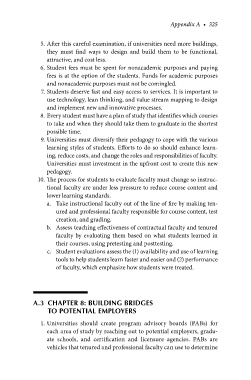Page 355 - Crisis in Higher Education
P. 355
Appendix A • 325
5. After this careful examination, if universities need more buildings,
they must find ways to design and build them to be functional,
attractive, and cost less.
6. Student fees must be spent for nonacademic purposes and paying
fees is at the option of the students. Funds for academic purposes
and nonacademic purposes must not be comingled.
7. Students deserve fast and easy access to services. It is important to
use technology, lean thinking, and value stream mapping to design
and implement new and innovative processes.
8. Every student must have a plan of study that identifies which courses
to take and when they should take them to graduate in the shortest
possible time.
9. Universities must diversify their pedagogy to cope with the various
learning styles of students. Efforts to do so should enhance learn-
ing, reduce costs, and change the roles and responsibilities of faculty.
Universities must investment in the upfront cost to create this new
pedagogy.
10. The process for students to evaluate faculty must change so instruc-
tional faculty are under less pressure to reduce course content and
lower learning standards.
a. Take instructional faculty out of the line of fire by making ten-
ured and professional faculty responsible for course content, test
creation, and grading.
b. Assess teaching effectiveness of contractual faculty and tenured
faculty by evaluating them based on what students learned in
their courses, using pretesting and posttesting.
c. Student evaluations assess the (1) availability and use of learning
tools to help students learn faster and easier and (2) performance
of faculty, which emphasize how students were treated.
A.3 CHAPTER 8: BUILDING BRIDGES
TO POTENTIAL EMPLOYERS
1. Universities should create program advisory boards (PABs) for
each area of study by reaching out to potential employers, gradu-
ate schools, and certification and licensure agencies. PABs are
vehicles that tenured and professional faculty can use to determine

